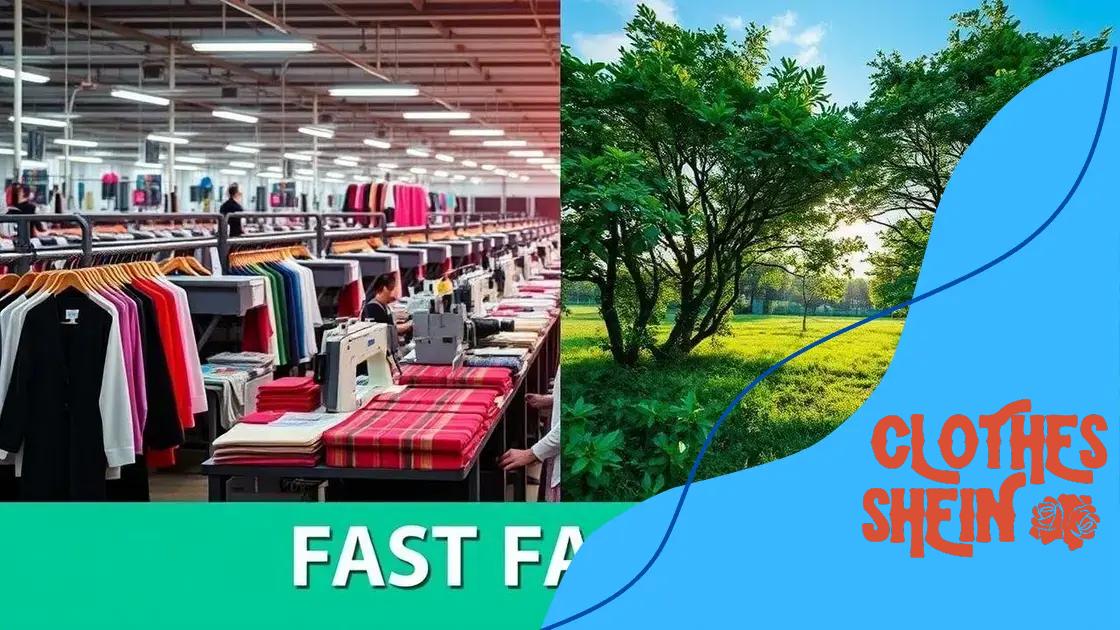How Shein is influencing global fashion trends

Shein is influencing global fashion trends by promoting fast fashion through affordable prices, rapid production cycles, and personalized online shopping experiences, while also facing increasing pressure to adopt sustainable practices.
How Shein is influencing global fashion trends captivates those curious about today’s styles. Have you ever wondered how this brand changes what we wear and how quickly trends shift? Let’s dive into its remarkable influence.
The rise of Shein in the fashion industry
The rise of Shein in the fashion industry has been nothing short of remarkable. Over recent years, this brand has transformed how consumers shop and perceive fashion. Let’s explore the journey of Shein and its impact on this dynamic world.
Shein’s Strategy for Success
One of the keys to Shein’s success is its innovative approach to fast fashion. This involves frequently updating its inventory, allowing for a wide range of styles at affordable prices. By utilizing a data-driven strategy, Shein quickly identifies trending styles based on consumer behavior.
- Frequent clothing releases keep the catalog fresh.
- Data analytics helps predict fashion trends accurately.
- Affordable pricing appeals to young shoppers.
An essential factor is Shein’s engagement with its audience. The brand leverages social media platforms effectively to reach customers, often using influencers to promote their products. This strategy has created a community of dedicated shoppers eager to share their fashion finds.
The Global Reach of Shein
Shein has expanded its footprint across the globe, making it accessible to a diverse audience. By offering multilingual support and regional promotions, Shein caters to different markets and cultural preferences. Its online-only model eliminates traditional retail overhead, enabling lower prices.
Shein’s global reach also encourages a vibrant exchange of fashion ideas among countries. Customers from various backgrounds contribute to the brand’s style diversity. This ongoing interaction fosters an inclusive environment where fashion is constantly evolving.
With Shein’s rise, we also observe shifts in consumer behavior, as shoppers become more open to experimenting with more styles. The brand has made it easier than ever to explore various aesthetics without breaking the bank.
How Shein’s fast fashion model works
Understanding how Shein’s fast fashion model works is key to grasping its impact on the retail landscape. This approach leverages rapid supply chains and customer-driven trends to deliver the latest styles quickly and affordably.
Rapid Production Cycle
Shein operates on an incredibly fast production cycle. By producing small batches of new styles based on current market demands, the brand minimizes excess inventory while maximizing trend relevance. This model allows them to introduce hundreds of new items daily, ensuring that there is always something fresh for customers.
- Frequent updates keep customers engaged.
- Quick response to trending styles based on social media.
- Minimized waste by producing according to demand.
This speed is supported by an extensive network of manufacturers. Shein collaborates with multiple suppliers, streamlining the process from design to delivery. By maintaining close relationships with these producers, Shein can adjust its offerings swiftly.
Data-Driven Design
Another essential component is Shein’s use of data analytics. The company monitors consumer behavior through its online platform, gaining insights on which styles are popular. This information informs design decisions, guiding what new pieces to produce. By leveraging customer preferences, Shein can cater directly to what shoppers want, rather than relying solely on traditional fashion forecasts.
As a result, the brand often introduces designs that resonate with its audience. This responsiveness not only boosts sales but also fosters a unique connection between Shein and its consumers, reinforcing brand loyalty.
Moreover, Shein emphasizes affordability, which makes fashion accessible to a broader audience. By offering stylish options at competitive prices, the brand appeals particularly to young consumers who are looking to express themselves without overspending.
Impact of Shein on sustainability practices

The impact of Shein on sustainability practices is a topic of growing relevance in today’s fashion industry. As this fast fashion giant continues to expand, questions about its environmental footprint and social responsibility arise.
Understanding Shein’s Environmental Footprint
Shein’s rapid production methods significantly contribute to its environmental impact. The brand produces large quantities of clothing in short time frames, leading to concerns about waste generation and resource usage. This model often prioritizes speed over sustainability.
- High levels of textile waste result from unsold items.
- Excessive water usage in garment production is problematic.
- Chemical runoff from manufacturing can pollute local ecosystems.
Even with these issues, Shein is making attempts to address sustainability. The brand has started initiatives aimed at reducing waste and promoting more responsible production methods. These include improving supply chain transparency and exploring eco-friendly materials.
Consumer Awareness and Response
Consumers are increasingly aware of the implications of their purchases, prompting brands like Shein to rethink their approach. Many shoppers now prioritize sustainability and demand more ethical practices from their favorite retailers. This shift in consumer behavior pressures Shein to adapt and innovate.
In response, Shein has launched programs aimed at recycling and upcycling, allowing customers to return used clothing for potential reuse or recycling. This program reflects a growing acknowledgment within the brand of the need to be more environmentally responsible.
Ultimately, Shein stands at a crossroads between fast fashion convenience and the growing need for sustainability. The brand’s future may depend on how well it can integrate eco-friendly practices into its model without sacrificing its core appeal of quick style availability at low prices.
Consumer behavior shifts due to Shein
The consumer behavior shifts due to Shein are significant in shaping the modern retail landscape. As this brand continues to grow, it has changed how shoppers approach fashion consumption and trends.
Emphasis on Affordability and Variety
One major shift seen in consumers is a growing emphasis on affordability. Shein’s low prices attract shoppers who may have previously spent more on quality items. This change encourages a mindset where frequent purchasing becomes the norm rather than investing in fewer, higher-quality pieces.
- Shoppers are looking for stylish options at lower prices.
- Fast fashion allows consumers to explore multiple trends easily.
- This encourages a “wear it once” mentality rather than long-term ownership.
As shoppers increasingly prioritize variety in their wardrobes, Shein’s model allows them to experiment with different styles without commitment. This has led to a sense of freedom in personal expression, helping individuals showcase their unique identity through varied fashion choices.
Online Shopping Dominance
Another notable change is the rise of online shopping as the preferred method for purchasing clothing. Many consumers now favor digital shopping experiences over traditional retail. Shein’s robust online platform capitalizes on this trend, offering a diverse selection of items with just a few clicks.
Convenience plays a key role here. Shoppers enjoy browsing new collections from the comfort of their homes. Features like user reviews, styling suggestions, and personalized recommendations make online shopping more engaging and tailored to individual tastes.
Additionally, social media influences consumer behavior by shaping trends and introducing new products. Shein effectively uses platforms like Instagram and TikTok to showcase items and engage with users. Videos of influencers wearing Shein outfits create a sense of urgency and desire, further driving sales.
Overall, the shifts in consumer behavior due to Shein illustrate a broader transformation in the fashion industry, where quick styles, affordability, and online shopping reshape how people interact with fashion.
Future trends influenced by Shein
The future trends influenced by Shein signify a new era in fashion, where style meets rapid adaptability. As Shein continues to reshape the landscape, it will likely drive several key trends moving forward.
Increased Focus on Personalization
One emerging trend is the growing demand for personalized shopping experiences. Consumers want clothing that reflects their unique tastes. Shein’s data-driven approach allows it to recommend styles tailored to individual preferences, setting a standard for future retail models.
- Users expect more customized options when shopping.
- AI technology will play a larger role in understanding consumer preferences.
- The desire for unique pieces will challenge brands to adapt.
As personalization becomes more prevalent, Shein will likely lead the way by offering customizable clothing options, allowing customers to choose colors, patterns, and styles that best represent them.
Technological Integration in Shopping
Another trend is the integration of advanced technologies in the shopping experience. With the rise of augmented reality (AR) and virtual fitting rooms, Shein can enhance the way consumers interact with fashion online. This innovative approach builds confidence in purchases and reduces return rates.
Imagine stepping into a virtual dressing room where you can try on clothes virtually before buying. This technology, now gaining traction, will likely become commonplace in Shein’s strategy.
Furthermore, the use of chatbots and AI-driven customer service will improve the overall shopping experience. Customers can receive instant support, making online shopping more engaging and efficient.
Sustainability and Ethics
As consumers grow more environmentally conscious, Shein’s future will likely involve an increased focus on sustainable practices. Although the brand has faced criticism for its environmental impact, shifting public demand may push it to adopt greener initiatives.
Potential efforts include using sustainable materials, optimizing production methods, and implementing recycling programs. The demand for sustainable fashion will reshape not only Shein but also the broader industry, prompting changes in how clothing is produced and consumed.
In conclusion, the future trends influenced by Shein will revolve around personalization, technological advancements, and sustainability. These elements will define how consumers shop and interact with fashion in the years to come.
In summary, Shein’s influence on global fashion is undeniable. The brand’s fast fashion model has reshaped consumer behavior, prioritized affordability, and leveraged technology beautifully. As we move forward, trends toward personalization, sustainability, and technological integration will likely define Shein’s impact on the industry. Consumers are more conscious than ever of their choices, so Shein must adapt and innovate. Embracing these changes will ensure its success in an ever-evolving market.
FAQ – Frequently Asked Questions About Shein and Its Impact on Fashion
How does Shein influence consumer behavior?
Shein influences consumer behavior by promoting affordability and variety, encouraging shoppers to frequently update their wardrobes.
What role does technology play in Shein’s shopping experience?
Shein integrates advanced technologies like AI and augmented reality to enhance online shopping, making it more engaging and personalized.
Is Shein taking steps towards sustainability?
Yes, Shein is beginning to address sustainability by exploring eco-friendly practices and launching recycling programs in response to consumer demand.
What future trends can we expect from Shein?
Future trends may include greater personalization in shopping experiences, increased use of sustainable materials, and further technological integration to meet consumer demands.





